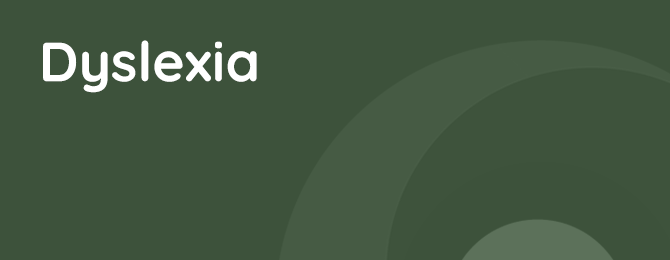Dyslexia

What is dyslexia?
Dyslexia is a specific learning difficulty that affects reading and writing. It is caused by differences in the way the brain processes language.
People with dyslexia may have difficulty with:
- Reading and this may include difficulty with word recognition, reading comprehension, and fluency.
- Writing and this may include difficulty with spelling, grammar, and punctuation.
- Phonological awareness and the ability to identify and manipulate the sounds in words.
- Phonics and the relationship between letters and sounds.
- Rapid naming and the ability to quickly name letters, numbers, and objects.
Signs and symptoms of dyslexia
The signs and symptoms of dyslexia can vary from person to person. Some common signs and symptoms include:
- Difficulty learning to read and write
- Difficulty with spelling and grammar
- Slow reading speed
- Difficulty with reading comprehension
- Difficulty with following instructions
- Difficulty with word recognition
- Difficulty with phonics
- Difficulty with rapid naming
Assessment of dyslexia
Dyslexia is assessed by a qualified professional, such as a psychologist or educational psychologist. The assessment will involve a range of tests to assess the individual's literacy skills and cognitive abilities.
Best practice interventions for dyslexia
The best practices for interventions for dyslexia are multisensory and systematic. They should focus on developing the individual's literacy skills in a structured and sequential way.
Some examples of effective interventions for dyslexia include:
- Phonics-based instruction: This type of instruction teaches students the relationship between letters and sounds.
- Multisensory instruction: This type of instruction uses multiple senses, such as sight, hearing, and touch, to teach literacy skills.
- Explicit instruction: This type of instruction provides clear and direct instruction on literacy skills.
- Systematic instruction: This type of instruction is structured and sequential, and it builds on previously learned skills.
Supporting children with dyslexia at home
There are many things that parents and carers can do to support children with dyslexia at home. These include:
- Providing extra help with reading and writing. This could involve reading to the child, helping them with their homework, or using educational software.
- Creating a supportive home environment. This could involve providing the child with a quiet place to study and having realistic expectations of their abilities.
- Advocating for the child's needs at school. This could involve talking to the child's teacher about their needs and ensuring that they are receiving the right support.
Who can help me?
If your child has dyslexia or you have any questions or concerns then please contact the Plymouth Early Help and SEND Advice Line. You can book a conversation with a Family Support Worker. Just call 01752 668000, or email AccessEarlyHelp@plymouth.gov.uk.
Frequently asked questions
What is dyslexia?
Dyslexia is a specific learning difficulty that affects reading and writing. It is a lifelong condition, but with the right support, people with dyslexia can thrive.
What are the signs and symptoms of dyslexia?
Common signs and symptoms of dyslexia include difficulty with reading, writing, and spelling. People with dyslexia may also have difficulty with phonological awareness, phonics, and rapid naming.
How is dyslexia assessed?
Dyslexia is assessed by a qualified professional, such as a psychologist or educational psychologist. The assessment will involve a range of tests to assess the individual's literacy skills and cognitive abilities.
What are the best practice interventions for dyslexia?
The best practice interventions for dyslexia are multisensory and systematic. They should focus on developing the individual's literacy skills in a structured and sequential way.
How can parents and carers support children with dyslexia?
There are many things that parents and carers can do to support children with dyslexia. These include providing extra help with reading and writing, creating a supportive home environment, and advocating for the child's needs at school.
Plymouth City Council's dyslexia guidance
- Appendix 1 - High-quality teaching access strategies (PDF) [127KB]
- Appendix 2 - Reviewing a learner with literacy difficulties (PDF) [136KB]
- Appendix 3 - City College Plymouth Workplace Information (PDF) [142KB]
- Appendix 4 - Parent letter template (Word doc) [11KB]
Plymouth's Local Offer is organised into four main categories covering the following age ranges:
- Early years (0 to 5 years old)
- Primary (5 to 11 years old)
- Secondary (11 to 18 years old)
- Preparing for adulthood
Is the information correct?
Let us know if the information on this page is wrong and needs to be updated.






